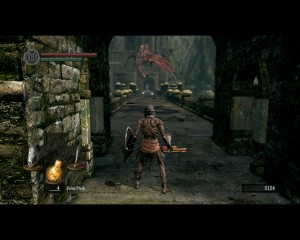Playing through Dark Souls 2, I was left feeling very frustrated by the level design and how the move to an open world or non linear structure in my opinion has hurt the series as a whole. One of the problems is that for new people trying to learn how the series works, the level designs and general structure are becoming more and more inaccessible in their philosophy. This is a shame as I felt that From Software nailed it with the original Demon’s Souls and one of the best examples of level design I’ve seen.
A Murderous Microcosm:
The general gameplay of Demon’s and Dark Souls 1 and 2 has not changed in their basic design. All three are about challenging real time battles where positioning, patience and timing are more important than leveling up. But when you have a series that is focused so much on challenging gameplay, you really need a great tutorial or first act to ease the player into what they’re going to be up against.
Because the Souls series relies so much on player skill, this is even more important as leaving any detail out about design or structure will follow through in the later levels.
Now with the Souls series, we can break down what’s considered the tutorial or “first act” by how many sections it takes to go over the mechanics, introduce the systems the player will use and fight the first real boss.
For Demon’s Souls that would be the starting area followed by world 1-1. Dark Souls would be the prison and Undead Berg and Dark Souls 2 would be InBetwixx, and The Forest of Giants.
World 1-1 in Demon’s Souls is important as the player cannot level up or go on to other levels until they can beat the first boss. This is why the structure of the level was vital as the player has no means of improvement other than any items found or bought from the shopkeepers.
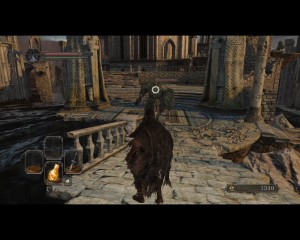
Where both Dark and Demon’s Souls introduced new and varied enemies slowly, Dark Souls 2 constantly threw new enemies at the player, but with the same attack patterns.
Because of these limitations, the level design had a great logical consistency and progression to it to make you feel like you were both exploring and making some forward momentum.
You first start fighting basic undead grunts with a few attacks. These enemies came in small groups and were slow enough that even if you pulled more than one, you could still fight them pretty well.
There were only a small number of advanced enemies in the level in the form of the blue eyes knights. Two unique situations were the red eyes knight hidden in the far corner of the level and maneuvering around dragons. The former could be taken out early using the level while the later required the player to be good at moving around to avoid.
Both these situations were harsh lessons in trying to just bum rush through everything and required a bit more strategy. Trying to fight either one like the normal enemies would get the player killed. Players could earn some really good items including a great shield for braving the dragon’s area while the red eyes knight gave out a lot of souls for such an early encounter.
The boss was with a giant creature that was weak against fire damage. While this boss was a challenge for melee focused builds, it was also a good lesson in using consumable weapons in the form of firebombs to take it apart.
The beauty of the level design was that the entire level flowed around the main gate as this was where the boss was located. Two shortcuts were setup so that the player could open them that would take them up the towers with the first one unlocked after a few minutes of play. This meant that it didn’t take long for someone to actually make some permanent progress in the level.
The blue eyes knights only appeared in a few areas and required the player to start understanding the finer points of combat to win.
There were also secrets for the player to find including a store that sold (at the time) better equipment and a way to meet one of the few friendly NPCs in the game.
All this equates to essentially a self contained “tutorial 2” for Demon’s Souls. By the end of the level the player should understand the finer points of combat, avoiding damage, environmental obstacles and uses, dangers that should be avoided, hidden areas and shops and the importance of items. The boss was with a creature that proved to be difficult for melee builds but was susceptible to items and ranged fighters.
Anyone who completed world 1-1 would have a great understanding of the rules of the world which are then built upon for later levels.
A World of Hurt:
Dark Souls was pretty good in teaching the basic mechanics as the prison serves as both tutorial and level one of the game. You can’t move on or level up until you’ve gotten through the prison and fought the boss. And the level was set up with shortcuts that the player could use to once again add some progression.
The only problems with the prison were that the designers did not introduce a true second enemy like the blue eyes knights to test the player on combat. Instead that was rolled into the first boss fight who while was a great test of combat, wasn’t the same as the first boss of Demon’s Souls. Outside of learning the attack pattern, the boss was just like fighting one of the regular enemies but bigger.
The remainder of the mechanics wouldn’t be introduced until the player gets through Undead Burg. Here, the player will find shops, hidden areas and fight two different bosses. But one area where Dark Souls does beat Demon’s Souls on is introducing both the blacksmith and getting easy access to him and materials to power up their equipment early in the game.
With nearby enemies providing titanite shards, it was easy for players to grind out the items to upgrade their starting equipment as an edge against the Gargoyles. And with the shortcut back to fire link, the player was always close to the blacksmith whenever they needed to upgrade.
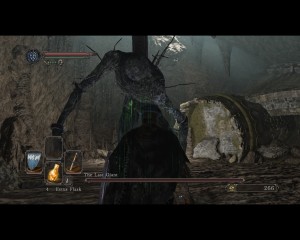
The first boss fight in Dark Souls 2 was with an enemy that didn’t do as much to test the player compared to the first boss in Demon’s Souls.
Undead Burg was a bit bigger than World 1-1 in Demon’s Souls as the area connects to several other areas.
Similar to Demon’s Souls, the player will run into three major challenges that can mess with new players: black knights, armored boar and a dragon. While the first two can be conquered by crafty players, the dragon stands as a major obstacle.
Design wise, the issue that I have with Undead Burg is that a lot of the level still required the player to run around in as there was only one real shortcut: From the first bonfire that takes you to under the bridge. The other shortcut doesn’t cut travel time in Undead Burg, but acts as a shortcut back to fire link shrine.
Moving on to Dark Souls 2, as mentioned the “tutorial” consists of both the area of Inbetwixx and The Forest of Giants. Inbetwixx is quite bare bones, featuring one enemy type (on the main path) and just a general run through the mechanics. This is also the only tutorial where there isn’t a giant boss or test waiting for the player. And expert players can just run straight through and get to the hub area. The only downside is missing out on picking up a dagger which for deprived characters is their only starting weapon.
The forest itself is decent size and is comparable to Demon’s Souls 1-1. There are are more enemy types in this area compared to the first area in Demon’s Souls. You have regular infantry, hollow soldiers, turtle guards and an optional fight with the Hilde Knight. The game doesn’t wait long to introduce the hollow soldiers with two of them between you and the first bonfire.
The first bonfire is important as it acts as the level’s central hub where the remaining areas and shortcuts stem from. This is also where the player will meet the second shopkeeper in the game and can unlock the use of a blacksmith back in the main town.
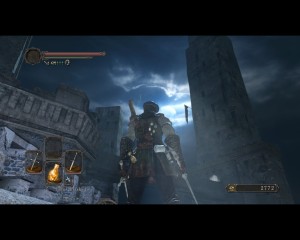
The level design in Dark Souls 2 didn’t feel as creative or well made compared to Dark Souls and Demon’s Souls.
Below the bonfire is where the player will find the connecting area to the remaining parts of the level. This includes the only unlockable shortcut that is used to get easy access to the two bosses.
The boss plays out similarly to the first boss fight in Dark Souls: A giant creature with wide range but slow attacks. The second boss is really meant to be fought later or with backup due to having much higher stats than the first boss.
What I don’t like about the area is that the level itself as a whole feels too similar to each part of it. Despite one area requiring you to make a leap of faith, you’re just moving through killing the same types of enemies. There are no dragons or large environmental obstacles to deal with. Two areas that act as “side quests” end abruptly with the player simply returning to the main path.
The most interesting part would be a mini dungeon that you only have one chance to go through as the door locks behind you. But I was able to get to it from another path. Another major factor about Dark Souls 2 compared to Demon’s Souls, is that the ability to level up is available from the get-go, while Demon’s Souls challenges you to beat world 1-1 without it or Dark Souls 1’s prison.
This is a major point in terms of game balance as the designers of Demon’s Souls balanced the level on the fact that someone playing it would be stuck with their basic stats. Dark Souls 2 was more demanding to compensate for being able to level up from the get-go.
What it comes down to is that by the end of world 1-1, the player is tested on what to expect from the design and how to play the game against the variety of threats. While Dark Souls 2 just presents a simple gauntlet of rooms without any real escalating fight. The boss is less about figuring out a unique challenge like in Demon’s Souls, but simply fighting something tougher and stronger than the other enemies in the level.
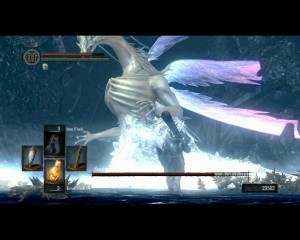
Unique boss fights seen in Demon’s and Dark Souls, challenged the player with specific situations to test their ability.
That sense of each area being its own “mini universe,” is what I liked about Demon’s Souls. Each world feels massive enough while feeling like a cohesive place.
With that said though, I do like Dark Souls 1’s approach to world design with each area fitting together and being connected through shortcuts.
If Demon’s Souls could be compared to exploring a variety of self contained dungeons, Dark Souls was like exploring an entire world. I’m not going to touch too much on Dark Souls 2 here as I’ve already said enough in part 1 and part 2 of my analysis.
Very few games have delivered amazing first levels that not only introduce the game to the player, but teach and reward them with what they need to know. A strong beginning can do much to get someone invested in the challenges to come. And with a challenging series like the Souls games, you need all the help that you can get.


